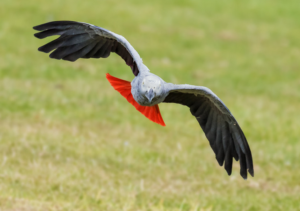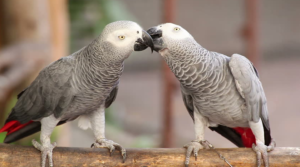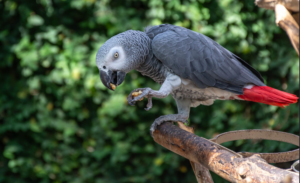An African Grey Parrot | Bird facts
An African Grey Parrot | Bird facts : is generally is an old world parrot in the family Psittacidae and a native to Central and West Africa. The specie is also a native to African countries such as Uganda, Ghana, Kenya, Somalia, Nigeria Liberia Tanzania, etc. Besides, this bird’s ability to talk and mimic sounds and phrases makes this medium-sized parrot a captivating companion. It can also understand human speech and a well-trained one can learn hundreds of words, phrases and sounds. Therefore, this has helped to catapult this species to stardom in research circles and the pet trade.
Physical description
As its name suggests, the African grey parrot is a mottled grey colored bird. At first glance, the species is a medium-sized, dusty-looking grey bird almost pigeon-like. In addition, the species has various shades of grey with very distinctive red vent and tail feathers and solid black beaks. They also have bare white face patches and at times bright, normally pale, silvery eyes. Furthermore, some grey parrots are partially or completely red and both sexes appear similar. However, females have a pale grey crown with dark grey edges, a grey body and scarlet tail feathers.
 Many of the grey contour feathers are edged with white, giving them a smooth, lacy appearance. In fact, at a certain degree, they tend to be sexually dimorphic. One can basically differentiate the sex of these birds once the birds is nearly 18 months of age. Here, the male parrot’s tail remains solid red while a female’s tail becomes red but tipped with silver. The underparts of the male’s wings become dark while for the female’s remain light. Secondly, sex can be differentiated according to the size whereby males have a more slender and narrower head. On the other hand, the females have got longer necks with larger and rounder heads.
Many of the grey contour feathers are edged with white, giving them a smooth, lacy appearance. In fact, at a certain degree, they tend to be sexually dimorphic. One can basically differentiate the sex of these birds once the birds is nearly 18 months of age. Here, the male parrot’s tail remains solid red while a female’s tail becomes red but tipped with silver. The underparts of the male’s wings become dark while for the female’s remain light. Secondly, sex can be differentiated according to the size whereby males have a more slender and narrower head. On the other hand, the females have got longer necks with larger and rounder heads.
African Grey Parrot facts
Behavior
The African grey parrots are generally very shy and rarely allow humans to approach them easily. They are highly social and nest in large groups however each group or family occupies their own nesting tree. Like the other birds, they are also observed roosting in large noisy flocks calling loudly usually during the morning, evening and when in flight. They also choose spots high up in the trees, to sleep where they are safest from predators. These birds are also gregarious and very noisy especially at night when they gather in flocks to sleep in tall trees. Besides, these birds communicate with each other using high-pitched screams and whistles in various conditions. These include; detecting predators, food, their location, safety statues, etc.
 Unlike other parrots that are often found in mixed flocks, these flocks always comprise of only African grey parrots. Furthermore, during the day, they break into smaller flocks and fly longer distances to forage. The young birds stay with their family groups for a long period of time for several years. They socialize with others of their agemates in nursery trees, however remain in their family groups within the larger flocks. They are also cared for by older birds until they are educated enough and old enough to become independent flock members. The young need to learn a complex set of skills such as differentiating desirable food plants from toxic plants, how to recognize and avoid predators, how to defend territory, etc.
Unlike other parrots that are often found in mixed flocks, these flocks always comprise of only African grey parrots. Furthermore, during the day, they break into smaller flocks and fly longer distances to forage. The young birds stay with their family groups for a long period of time for several years. They socialize with others of their agemates in nursery trees, however remain in their family groups within the larger flocks. They are also cared for by older birds until they are educated enough and old enough to become independent flock members. The young need to learn a complex set of skills such as differentiating desirable food plants from toxic plants, how to recognize and avoid predators, how to defend territory, etc.
More behaviors
In addition, the young exhibit appeasement behaviors towards older members. However, as they mature, they become more aggressive with conspecifics. Additionally, they also learn how to develop role-appropriate behaviors that include competing and defending nest sites and raising off springs. Since these parrots are partial ground feeders, there is a series of behavioral events that occur before landing and safe consumption takes place.
Groups of parrots gather at a barren tree not until it is completely filled with hundreds of birds. These birds take part in grooming, climbing, socializing and vocalizing. Eventually, they make their way down to the ground in waves with the entire group. Once on the ground, they are extremely vigilant reacting to any movement or sound. Furthermore, studies have found that these birds have complex cognition and are considered one of the most intelligent species of birds since they can also test and form ideas about the world.
Habitant
Habitants of African grey parrots are frequently moist lowland forests. They are commonly observed in the mangroves, wooded savannahs, forest edges, cultivated areas, gardens, etc. In addition, they make their nests in tree holes and at times choose locations abandoned by birds such as woodpeckers. Furthermore, they often visit open lands next to woodlands in order to roost in trees over water.
Reproduction
These parrots are social birds and their breeding occurs in loose colonies with each pair occupying its own tree for nesting. They also select mates carefully and have a life time monogamous bond that begins at sexual maturity, at three to five years of age. During courtship, males feed mates and both sing soft monotonous notes. At this time the females will sleep in the nest cavity while the male guards it. In captivity, males feed females after copulation events and both participate in a mating dance in which they drop their wings. Wing pumping also takes place and this gives the impression of slow motion flight and consequently, the body feathers will also be flared or displayed.
 The breeding season varies by locality however appears to coincide with the dry season. These grey parrots usually breed twice a year and normally mate several times a day for several weeks before the first egg is laid. Females lay a clutch of three to five roundish eggs, each at intervals of two to five days. However, the females incubate the eggs while being fed entirely by the males. Incubation takes approximately (26-30) days with the average being 28 days. Fledgling from the nest is always at (10-12) weeks of age. After the young emerging from the nest, weaning takes another 3-4 weeks by both parents nourishing, raising and protecting their off springs until they reach independence.
The breeding season varies by locality however appears to coincide with the dry season. These grey parrots usually breed twice a year and normally mate several times a day for several weeks before the first egg is laid. Females lay a clutch of three to five roundish eggs, each at intervals of two to five days. However, the females incubate the eggs while being fed entirely by the males. Incubation takes approximately (26-30) days with the average being 28 days. Fledgling from the nest is always at (10-12) weeks of age. After the young emerging from the nest, weaning takes another 3-4 weeks by both parents nourishing, raising and protecting their off springs until they reach independence.
Speech and vocalization
Much of the grey parrot’s appeal comes from its talking ability and is among the best talkers in the parrot family. As a matter of fact, it is able to repeat words and phrases after hearing them just once or twice. This specie basically reaches full talking ability around a year of age and most of them become capable mimics much earlier. The flocks or groups follow a daily pattern of vocalizations, normally the flock is quiet from sunset until the next dawn. During day break, the flock begins to vocalize before setting out to forage at different locations throughout the day.
There are also a variety of different types of calls and vocalizations. These include; contact calls, food begging calls, agonistic calls, alarm calls, not to mention a few. Contact calls are of particular importance because they serve to identify where other members of the flock as well as help promote flock cohesion. Additionally African grey parrots demonstrated a complex cognitive competence in understanding both the similarities and dissimilarities among different musical note frequencies.
It was also determined that an African grey parrot can isolate a sound from background noise and imitate it. It can also encode it into long term memory and monitor the output sound to match it with the internal template. In fact, one of the African grey was reported blowing off a woman’s love affair by repeatedly calling out the other man’s name in front of her husband. It did this while using the cheating wife’s voice. Surprisingly, once they learn a word or sound, it is impossible or difficult to forget or unlearn it.
Feeding
 These birds are basically herbivores and frugivores which means that the vast majority of their diet consists of fruits. Their primary food sources are generally fruits, seeds and nuts. However, they are also known to eat tree bark, insects, flowers and snails. Their favorite food source in the wild is usually oil palm fruit. Besides, when searching for food, these birds fly or climb to the ground to forage for ripe fruit that has fallen from tress. The best food for an African grey parrot in captivity is a high-quality formulated pellet supplemented with fruits. These include; apples, pears, carrots, oranges, bananas, cucumbers, peas, celery, seeds, melon, etc. Additionally, they also provide fresh vegetables such as leafy greens like sprouts and healthy seeds like flaxseeds.
These birds are basically herbivores and frugivores which means that the vast majority of their diet consists of fruits. Their primary food sources are generally fruits, seeds and nuts. However, they are also known to eat tree bark, insects, flowers and snails. Their favorite food source in the wild is usually oil palm fruit. Besides, when searching for food, these birds fly or climb to the ground to forage for ripe fruit that has fallen from tress. The best food for an African grey parrot in captivity is a high-quality formulated pellet supplemented with fruits. These include; apples, pears, carrots, oranges, bananas, cucumbers, peas, celery, seeds, melon, etc. Additionally, they also provide fresh vegetables such as leafy greens like sprouts and healthy seeds like flaxseeds.
Where to find them in Uganda
In Uganda will find them in forests from 700-2300 meters and in cages at Uganda Wildlife Conservation Education Center.






